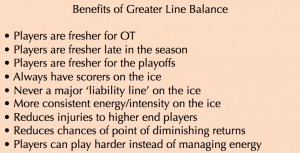Teams and coaches often talk about ‘rolling four lines’. San Jose Sharks coach Peter DeBoer is among those who say he wants to roll four lines.
What does “rolling four lines” mean? It means the coach has confidence in all four of his forward lines so each line gets a substantial share of ice time. Typical fourth lines will get around ten minutes of ice time per game. The New York Islanders fourth line, noted for playing very physical hockey, will typically play closer to 12 minutes per night. However, on other teams, the ice time could be considerably less than ten minutes if a coach does not trust them. For example, the Blackhawks bottom line forwards averaged just under six minutes of ice time in their January 6, 2016 game against the Penguins.
In order to roll four lines, it requires the fourth line to be good. The best way to make that happen is to put talent there. Adding talent to the lower lines comes at the expense of that talent residing on the top lines. How the coach balances the skill and talent among the lines is line balance. The more evenly the skill and talent is distributed, the more balanced. If there is a large talent discrepancy between lines, it makes rolling four lines a dangerous proposition, as the lower lines are likely to be liabilities.
Earlier, I wrote an article about quantifying line balance. I explained the benefits of greater line balance and discussed its drawbacks. One of the benefits is that teams can roll four lines.
The Sharks Issues With Line Balance
Coach DeBoer has been open about wanting to roll four lines. He discussed this in the preseason and has occasionally revisited that theme during the season. For most of the season, it has been not been difficult to determine if the Sharks are rolling four lines. They haven’t.

Earlier in the season, DeBoer had his hands tied with injuries. Ben Smith, Logan Couture and Melker Karlsson all had extended absences with injuries. The everyday line-up varied substantially as the coach tried various combinations. Several games featured roles players coming up from the Sharks AHL affiliate, the San Jose Barracuda.
Is the reason DeBoer did not roll four lines because he simply didn’t have the players to give it a fair chance? The time to assess that is now. The Sharks forwards are healthy (except for the suspended Raffi Torres), so we can see if DeBoer is serious about wanting to roll four lines.
Quantifying Line Balance For the Sharks
A quick overview of how I quantify line balance, the full version is at this link. Simply put, all forwards are ranked. The ranking is their value, The top player=1, the second best player=2 and so forth. Once a line is formed, the ranked values of the players are added together to get a line value. Line values are generated for all four lines, the difference between the top line and lowest line is the figure of merit used to determine line balance.
In order to remove any personal bias from the process, I enlisted the help of my THW colleagues Drew Weber, Andrew Bensch and Kenneth Laws. Each ranked the Sharks forwards and their composite rankings are here:
- Joe Pavelski
- Joe Thornton
- Logan Couture
- Patrick Marleau
- Joel Ward
- Tomas Hertl
- Joonas Donskoi
- Melker Karlsson
- Matt Nieto
- Tommy Wingels
- Dainius Zubrus
- Mike Brown, Chris Tierney, Ben Smith
Three players occupy the 12th spot. The reason for this is simple; only 12 forwards are on the ice for any given game.
Forwards 1-3 on this list have combined for 20 even strength (ES) goals (Couture, injured most of the season, has yet to have an even strength goal). Forwards 4-6 for 18 ES goals; forwards 7-9 for 12 ES goals and forwards 10-12 for 4 ES goals (Mike Brown was used in the 12th spot since he played most recently). The list, as ordered, does coincide with the scoring. It passes the sanity check.
On January 2nd, the Sharks iced the following lines to start the game
Melker Karlsson – Joe Thornton – Joe Pavelski (8+2+1=11)
Patrick Marleau – Logan Couture – Joel Ward (4+3+5=12)
Matt Nieto – Tomas Hertl – Tommy Wingels (9+6+10=25)
Dainius Zubrus – Chris Tierney – Joonas Donskoi (11+12+7=30)
On January 7, the next game, they iced the following
Melker Karlsson – Joe Thornton – Joe Pavelski (11)
Patrick Marleau – Logan Couture – Joel Ward (12)
Matt Nieto – Tomas Hertl – Tommy Wingels (25)
Joonas Donskoi – Dainius Zubrus – Mike Brown (30)

What is obvious from this, the Sharks have put almost all their top talent in the top two lines. The top five forwards appear on the top two lines. Only Melker Karlsson has been moved up, from the eighth spot, to be inserted in the top two lines. Since DeBoer went with almost identical lines (only swapping one player on the fourth line), the line balance figure of merit, 19, is same for both games. The figure of merit, 19, implies the lines are not very balanced, though I would not be surprised if that was typical of a number of teams. The maximum value for the figure of merit is 27 (10+11+12=33 is the highest and 1+2+3=6 the lowest), the minimum is 1 (19-18).
In the third period against Detroit, the Sharks rolled three lines in the third period, with DeBoer rotating in fourth liners Donskoi (onto the third line) and Zubrus (for Karlsson on the top line) into other lines on occasion. Still, in a sixty minute game (no OT), the three players assigned to the fourth line at the start averaged eight minutes of ice time. Meanwhile, Marleau Thornton and Pavelski averaged 20 minutes.
Will the Sharks Roll Four Lines?
My own opinion is that rolling four lines would be useful for the Sharks. The team features two high-end forwards that are 36 years-old (Thornton and Marleau). I documented their notable productivity drop-off in the second half of last season. There is no reason to think that, a year older, things will get better on that front if the Sharks play them heavy minutes again this year, which is the case so far.
Though my opinion is that rolling four lines would be helpful for the Sharks, I am not aware of any rigorous work that has shown a strong correlation between rolling four lines and team success. Currently, it seems to be more a case of conventional wisdom without sufficient analysis to support it. Conventional wisdom is not always correct. Ultimately, the coach needs to decide if rolling four lines is good for his team or not.
The Sharks coach has coalesced his talent to his top two lines. What can we conclude from this? We can conclude that DeBoer’s desire to roll four lines is more lip service than anything. He is not putting sufficient talent on the lower lines to give them the competitiveness required to make it work.
